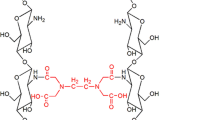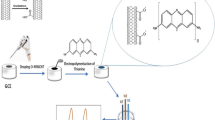Abstract
A multi-functional hybrid of cellulose acetate with cadmium sulfide and Methylene blue (CA/CdS/MB) in a bead composition was synthesized and investigated as a photosensor-adsorbent for the rapid, selective, and sensitive detection, and adsorption of Cu(II) ions. These hybrid CA-modified beads are composed of multiple adsorption active sites and possess a surface area of 58 cm2 g−1. They are an efficient adsorbent with a maximum adsorption capacity of 0.57 mg g−1. Photoelectrochemical (PEC) detection of Cu(II) was accomplished by modifying the beads on a glassy carbon electrode. The beads containing 20 mmol of sulfur displayed the widest linear analytical range (0.1–290 nM) and the lowest detection limit (16.9 nM) for Cu(II) with high selectivity and reliable reproducibility. The successful application of the beads has provided a new insight for the selection of a responsive photoactive material for a PEC assay, as well as an effective adsorbent material for Cu(II) ions.

A multi-functional hybrid of cellulose acetate with cadmium sulfide and Methylene blue (CA/CdS/MB) in a bead composition was synthesized and investigated as a photosensor-adsorbent for the rapid, selective and sensitive detection and adsorption of Cu(II) ions.






Similar content being viewed by others
References
Klemm D, Heublein B, Fink HP, Bohn A (2005) Cellulose: fascinating biopolymer and sustainable raw material. Angew Chem Int Ed 44(22):3358–3393
Coombs OBrien J, Torrente-Murciano L, Mattia D, Scott JL (2017) Continuous production of cellulose microbeads via membrane emulsification. ACS Sustain Chem Eng 5(7):5931–5939
Liu C, Bai R (2006) Adsorptive removal of copper ions with highly porous chitosan/cellulose acetate blend hollow fiber membranes. J Membr Sci 284(1–2):313–322
Ibrahim I, Lim HN, Abou-Zied OK, Huang NM, Estrela P, Pandikumar A (2016) Cadmium sulfide nanoparticles decorated with au quantum dots as ultrasensitive photoelectrochemical sensor for selective detection of copper (II) ions. J Phys Chem C 120(39):22202–22214
Ibrahim I, Lim H, Huang N, Pandikumar A (2016) Cadmium sulphide-reduced graphene oxide-modified photoelectrode-based photoelectrochemical sensing platform for copper (II) ions. PLoS One 11(5):e0154557
Wang X, Yan T, Li Y, Liu Y, Du B, Ma H, Wei Q (2015) A competitive photoelectrochemical immunosensor based on a CdS-induced signal amplification strategy for the ultrasensitive detection of dexamethasone. Sci Rep 5:17945
Ovchinnikov OV, Smirnov MS, Shatskikh TS, Khokhlov VY, Shapiro BI, Vitukhnovsky AG, Ambrozevich SA (2014) Spectroscopic investigation of colloidal CdS quantum dots–methylene blue hybrid associates. J Nanopart Res 16(3):2286
Smirnov M, Ovchinnikov O, Shatskikh T, Vitukhnovsky A, Ambrozevich S, Perepelitsa A (2014) Luminescence properties of hydrophilic hybrid associates of colloidal CdS quantum dots and methylene blue. J Lumin 156:212–218
Ju H, Zhou J, Cai C, Chen H (1995) The electrochemical behavior of methylene blue at a microcylinder carbon fiber electrode. Electroanalysis 7(12):1165–1170
Bartlett PN, Tebbutt P, Whitaker RG (1992) Kinetic aspects of the use of modified electrodes and mediators in bioelectrochemistry. ChemInform 23(5). https://doi.org/10.1002/chin.199205314
Rakovich A, Savateeva D, Rakovich T, Donegan JF, Rakovich YP, Kelly V, Lesnyak V, Eychmüller A (2010) CdTe quantum dot/dye hybrid system as photosensitizer for photodynamic therapy. Nanoscale Res Lett 5(4):753
Yao Q, Xiong Y, Wang H, Wang C, Sun Q (2017) MnO 2 nanoflakes/cellulose nanofibre aerogel fabricated via ultrasonication for high-performance water desalination. J Mater Chem A 5(20):9580–9590
Xiong Q, Bai Q, Li C, He Y, Shen Y, Uyama H (2018) A cellulose acetate/Amygdalus pedunculata shell-derived activated carbon composite monolith for phenol adsorption. RSC Adv 8(14):7599–7605
Jin X, Xu J, Wang X, Xie Z, Liu Z, Liang B, Chen D, Shen G (2014) Flexible TiO 2/cellulose acetate hybrid film as a recyclable photocatalyst. RSC Adv 4(25):12640–12648
Liu H, Hsieh YL (2002) Ultrafine fibrous cellulose membranes from electrospinning of cellulose acetate. J Polym Sci B Polym Phys 40(18):2119–2129
Gupta VK, Saleh TA, Pathania D, Rathore BS, Sharma G (2015) A cellulose acetate based nanocomposite for photocatalytic degradation of methylene blue dye under solar light. Ionics 21(6):1787–1793
Lu X, Shen X (2011) Solubility of bacteria cellulose in zinc chloride aqueous solutions. Carbohydr Polym 86(1):239–244
Hong C-H, Ki S-J, Jeon J-H, H-l C, Park I-K, Kee C-D, Oh I-K (2013) Electroactive bio-composite actuators based on cellulose acetate nanofibers with specially chopped polyaniline nanoparticles through electrospinning. Compos Sci Technol 87:135–141
Lin S, Chen L, Huang L, Cao S, Luo X, Liu K (2015) Novel antimicrobial chitosan–cellulose composite films bioconjugated with silver nanoparticles. Ind Crop Prod 70:395–403
Zhao H, Douglas EP, Harrison BS, Schanze KS (2001) Preparation of CdS nanoparticles in salt-induced block copolymer micelles. Langmuir 17(26):8428–8433
Alhaji N, Begum KTM (2015) Optimization and kinetic study for the removal of chromium (VI) ions by acid treated sawdust chitosan composite beads. Int Res J Pure Appl Chem 5(2):160
Alahabadi A, Rezai Z, Rahmani-Sani A, Rastegar A, Hosseini-Bandegharaei A, Gholizadeh A (2016) Efficacy evaluation of NH4Cl-induced activated carbon in removal of aniline from aqueous solutions and comparing its performance with commercial activated carbon. Desalin Water Treat 57(50):23779–23789
Chen X, Zhou S, Zhang L, You T, Xu F (2016) Adsorption of heavy metals by graphene oxide/cellulose hydrogel prepared from NaOH/urea aqueous solution. Materials 9(7):582
Liu L, Gao ZY, Su XP, Chen X, Jiang L, Yao JM (2015) Adsorption removal of dyes from single and binary solutions using a cellulose-based bioadsorbent. ACS Sustain Chem Eng 3(3):432–442
Chowdhury S, Saha P (2010) Sea shell powder as a new adsorbent to remove basic green 4 (malachite green) from aqueous solutions: equilibrium, kinetic and thermodynamic studies. Chem Eng J 164(1):168–177
Wan C, Jiao Y, Li J (2017) A cellulose fibers-supported hierarchical forest-like cuprous oxide/copper array architecture as a flexible and free-standing electrode for symmetric supercapacitors. J Mater Chem A 5(33):17267–17278
Acknowledgements
The research work was supported by FRGS MRSA (UPM/700-2/1/FRGS/MRSA/5524986) from the Ministry of Education of Malaysia.
Author information
Authors and Affiliations
Corresponding author
Ethics declarations
The author(s) declare that they have no competing interests.
Additional information
Publisher’s note
Springer Nature remains neutral with regard to jurisdictional claims in published maps and institutional affiliations.
Electronic supplementary material
ESM 1
(DOCX 8.17 mb)
Rights and permissions
About this article
Cite this article
Ibrahim, I., Lim, H.N. & Huang, N.M. Cellulose acetate beads modified with cadmium sulfide and Methylene blue for adsorbent-assisted photoelectrochemical detection of copper(II) ions. Microchim Acta 186, 452 (2019). https://doi.org/10.1007/s00604-019-3547-x
Received:
Accepted:
Published:
DOI: https://doi.org/10.1007/s00604-019-3547-x




